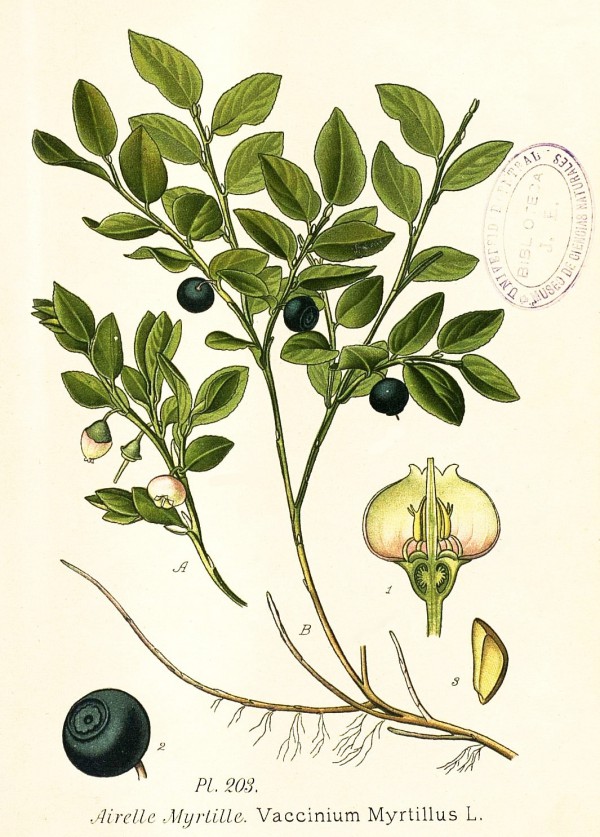Dies ist eine alte Version des Dokuments!
Vaccinium myrtillus L. - Ericaceae - bilberry, whortleberry, European blueberry, Heidelbeere, Blaubeere
Summergreen erect shrub, 15-50cm high, native to Eurasia, northwestern North America; twigs with edges, green; leaves ovate, serrulate, pale green; flowers green-red; fruits blue to black.
„The volatile components of bilberry, bog blueberry and cultivated high-bush blueberry (cv. Rancocas) were analysed by gas chromatography and mass spectrometry. Several new compounds not reported previously as blueberry volatiles were detected. These included methyl and ethyl 2-hydroxy-3-methylbutanoate, methyl and ethyl 3-hydroxy-3-methylbutanoate, 2-phenylethyl formate, methyl salicylate, farnesol, farnesyl acetate, vanillin, myristicine, 4-vinylphenol, 2-methoxy-5-vinylphenol, citronellol, hydroxycitronellol and some γ- and δ-lactones. The character impact compounds of bilberry were found to be the above-mentioned hydroxy esters together with 2-phenylethanol and its esters and the γ- and δ-lactones, whereas myristicine, citronellol, hydroxycitronellol, farnesol and farnesyl acetate were typical of the aroma of high-bush blueberry.“
[The aroma of blueberries., Hirvi, T., Honkanen, E., Journal of the Science of Food and Agriculture, Vol.34(9), 1983, 992-996]
„… HS-SPME analyses revealed complex volatile profiles including terpenes (23 compounds, e.g. p-cymene, 1,8-cineole, linalool) and aromatic structures (10 compounds, e.g. benzaldehyde, ethyl benzoate, 2-phenylethyl acetate, benzyl benzoate), which contribute to the characteristic and flavourful blueberry aroma.“
[Volatile profiles of European Blueberry: few major players, but complex aroma patterns., Rohloff, J., Nestby, R., Nes, A., Martinussen, I., Agronomijas Vēstis, Vol.(12), 2009, 98-103]
https://llufb.llu.lv/conference/agrvestis/content/n12/Latvia-Agronomijas-Vestis-12-2009.pdf
„Fruits and fruit extracts are recommended for treating diarrhea, especially in children. They are used locally to treat inflammation of the mucous membranes of the mouth and throat…The main active ingredients are mosytly catechol tannins (up to 12%) and proanthocyanidines…
The leaves are no longer recommended because prolonged use seemed to have toxic side effects… “
[Medicinal Plants of the World. Ben-Erik Van Wyk and Michael Wink, Pretoria 2004, 333]
Traditionally, to treat diarrhea in children, one let them chew (10g, several times a day) fresh blueberries (Myrtilli fructus recens) or dried ones (Myrtilli fructus siccus).
The leaves (Myrtilli folium) were formerly used to treat diarrhea, kidney problems and inflammation of mouth and troath, but efficacy has not been established. As the leaves contain quinolizidine alkaloids, especially (+) myrtine, prolonged use may have toxic side effects.
[Wolfgang Blaschek ed., Wichtl - Teedrogen und Phytopharmaka: Ein Handbuch für die Praxis, 2015, 443-447]

Masclef, A., Atlas des plantes de France, vol.3, t.203, (1891)
http://plantgenera.org/species.php?id_species=1048469
Vaccinium myrtillus
© Rolf Marschner (2006),
www.botanische-spaziergaenge.at
